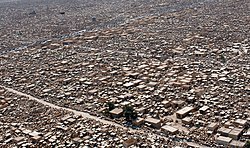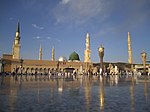Wadi-us-Salaam

Wadi-al-Salaam (Arabic: وادي السلام, romanized: Wādī al-Salām, lit. 'Valley of Peace') is an Islamic cemetery, located in the Shia holy city of Najaf, Iraq. It is the largest cemetery in the world.[1] The cemetery covers 1,485.5 acres (601.16 ha; 6.01 km2; 2.32 sq mi) and contains more than 5 million bodies.[2] It also attracts millions of pilgrims annually.[3]
The cemetery is located near the shrine of Ali ibn Abi Talib, the first Shia Imam, as well as the fourth Sunni Caliph.[4] Thus, many Shi'ites in Iraq request that they be buried in this cemetery.[4] As a result of improved transportation methods, Shi'ites from across the globe are (or seek to be) buried in the cemetery. However, burial at the cemetery "means being placed in one of the cemetery’s many catacombs."[5] According to an undertaker at the cemetery, each crypt can hold up to 50 bodies.[6] The burial plots are controlled by Marja'.[7]
The Shia traditions[]

Shia tradition holds that Abraham bought land in Wadi-us-Salaam and that Ali said the Wadi Al-Salaam was a part of heaven.[8] Shia also widely believe that Ali has the power to intercede for the deceased—lessening their suffering—during the passage of their soul from the worldly life[9] and if they are buried there "they will be raised from the dead on judgment day with their spiritual leader."[10]
The Shia are encouraged to bury their dead at the location through religious edicts[5] and the cemetery's expansion is also seen as being a result of Shi'isms "more permissive attitude than Sunnism with regard to the commemoration of the dead and the erection of mausoleums."[11]
Some rituals carried out before burial in the cemetery include: the body is washed and wrapped at the cemetery, the funeral prayers are conducted in the Imam Ali shrine, the deceased is carried around the shrine three times, and some Quranic verses are recited at the cemetery.[12]
History[]
Daily burials have been on going for over 1,400 years and the site is on the Tentative List of UNESCO's World Heritage sites.[13] Burials in Najaf have been documented as early as the Parthian and Sassanid eras and ancient Mesopotamian cities often had similar cemeteries, where there was an accumulation of tombs.[14]
It is estimated that during the Iraq War about 200 to 250 corpses were buried there daily; however, in 2010 this number had decreased to less than 100.[4] Approximately 50,000 new bodies are interred in the cemetery annually from across the globe.[15] This figure is an increase on the approximately 20,000 bodies, primarily from Iran, that used to be interred annually in the early 20th century.[16] Most Iraqi and many Iranian Shi'ites have a relative buried in the cemetery.[17]
As of 2014—coinciding with conflict against ISIL—it has been reported that burial plots are running out, resulting in many being stolen, illegally resold or improvised.[18] According to one gravedigger: “I’ve never had it so busy. Not even after 2003 or 2006 [the height of Iraq’s civil war]."[19]
Holy sites[]
- Grand Ayatollah Mohammad Mohammad Sadeq al-Sadr – his mausoleum is possibly the most visited in the cemetery.[20]
- Grave of Grand Ayatollah Muhammad Baqir al-Sadr[citation needed]
- Mosque of Prophet Hud. The mosque and tomb is located at the middle of the cemetery with its blue dome. Prophet Saleh is believed to be buried there as well.
- Maqam Imam Mahdi & Imam Jafar Sadiq
Prominent burials[]
- Rais Ali Delvari
- Khalou Hossein Bord Khuni Dashti
- Sayed Ali Qadhi Tabatabaei
- Abdul Hosein Amini
- Leyla Qasim
- Amina al-Sadr
- Grand Ayatollah Muhammad Sadeq Al-Sadr
- Grand Ayatollah Muhammad Baqir Al-Sadr
- , Vāli/Wāli of Posht-e-Kuh (modern day Ilam, Iran), and father of the last Vāli of Posht-e-Kuh .[21]
- Other religious figures
Notes and references[]
- ^ Hala Mundhir Fattah; Frank Caso (2009). A brief history of Iraq. Infobase Publishing. p. 140. ISBN 978-0-8160-5767-2. Retrieved 18 October 2010.
- ^ HOW BIG IS WADI-US-SALAAM CEMETERY?, washingtonmonthly.com.
- ^ Anthony Ham (15 Sep 2010). Middle East. Lonely Planet. p. 224. ISBN 9781742203591.
- ^ Jump up to: a b c Najaf cemetery witness to Iraq's tragic history, usatoday.com.
- ^ Jump up to: a b Qassem Fayyad (19 September 2012). "Wadi al-Salam: A Cemetery to Cleanse Sins". Al-Akhbar English. Retrieved 29 March 2015.
- ^ Yasser Tabbaa; Sabrina Mervin (28 July 2014). Najaf, the Gate of wisdom. UNESCO. p. 181. ISBN 9789231000287.
- ^ George Farag (2007). Diaspora and Transitional Administration: Shiite Iraqi Diaspora and the Administration of Post-Saddam Hussein Iraq. p. 131. ISBN 9780549410034.
- ^ Dumper, Michael; Stanley, Bruce E., eds. (2007). Cities of the Middle East and North Africa: A Historical Encyclopedia (illustrated ed.). ABC-CLIO. p. 269. ISBN 9781576079195.
There is also the tradition that Abraham bought land in the Wadi as-Salaam (Valley of Peace) that runs through the present city, predicting that it would be from here that 70,000 of those buried in the valley would be guaranteed entrance into paradise and would then be able to intercede with Allah for others. Imam Ali is reported to have said that Wadi as-Salaam was a part of heaven.
- ^ Yasser Tabbaa; Sabrina Mervin (28 July 2014). Najaf, the Gate of wisdom. UNESCO. pp. 162–3. ISBN 9789231000287.
- ^ MARIA ABI-HABIB (8 July 2014). "In Iraq, War Strains World's Largest Cemetery". The Wall Street Journal. Retrieved 30 March 2015.
- ^ Yasser Tabbaa; Sabrina Mervin (28 July 2014). Najaf, the Gate of wisdom. UNESCO. p. 162. ISBN 9789231000287.
In addition to historical precedence, there are at least two main factors that have contributed to the expansion of cemeteries around Najaf, and specifically in Wadi al-Salam. First, Shi'ism has developed a somewhat more permissive attitude than Sunnism with regard to the commemoration of the dead and the erection of mausoleums...
- ^ George Farag (2007). Diaspora and Transitional Administration: Shiite Iraqi Diaspora and the Administration of Post-Saddam Hussein Iraq. pp. 131–2. ISBN 9780549410034.
- ^ Wadi Al-Salam Cemetery in Najaf, unesco.org.
- ^ Yasser Tabbaa; Sabrina Mervin (28 July 2014). Najaf, the Gate of wisdom. UNESCO. p. 162. ISBN 9789231000287.
Such burial sites are quite common in ancient Mesopotamian cities, where the accumulation of tombs has created mounds on the outskirts of these early settlements
- ^ "Wadi al-Salam: The world's largest cemetery". Al Jazeera. 7 May 2019. Retrieved 30 July 2020.
- ^ Yasser Tabbaa; Sabrina Mervin (28 July 2014). Najaf, the Gate of wisdom. UNESCO. p. 163. ISBN 9789231000287.
- ^ Fair, C. Christine; Ganguly, Sumit, eds. (27 Aug 2008). Treading on Hallowed Ground:Counterinsurgency Operations in Sacred Spaces. Oxford University Press. p. 145. ISBN 9780199711895.
- ^ UNESCOPRESS (19 November 2014). "A new UNESCO publication pays tribute to Iraqi cultural heritage". Retrieved 30 March 2015.
- ^ "Islamic State: The pushback". The Economist. 21 Mar 2015. Retrieved 22 April 2015.
- ^ Yasser Tabbaa; Sabrina Mervin (28 July 2014). Najaf, the Gate of wisdom. UNESCO. p. 180. ISBN 9789231000287.
- ^ Yaghobi, Ebrahim; Yari, Sivash (2012). "Political Structure and Administrative System of Poshtkooh (Ilam) In the period of Valian". Life Science Journal. 9 (4): 3015, 3017. ISSN 1097-8135.
External links[]
Coordinates: 32°00′18″N 44°18′54″E / 32.00500°N 44.31500°E
- A Drone flying over the Cemetery - http://www.abc.net.au/news/2016-07-13/drone-footage-worlds-largest-cemetery/7625154
- Najaf
- Cemeteries in Iraq
- Shia cemeteries
- Arabic architecture
- Shia Islam in Iraq
- Islamic holy places
- Mahdism


